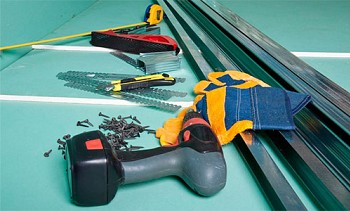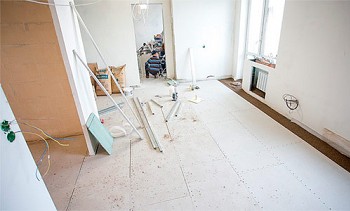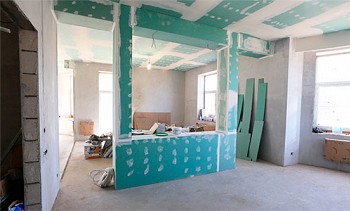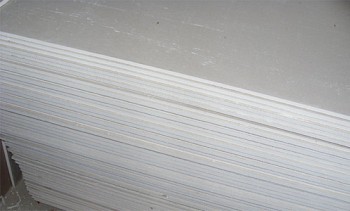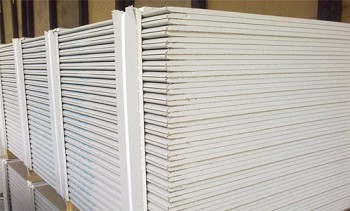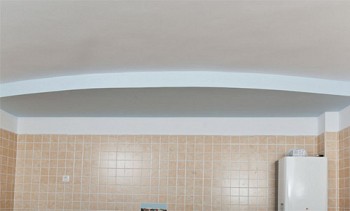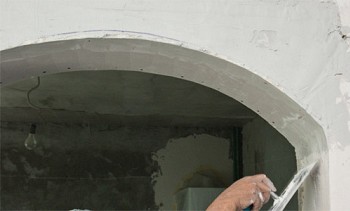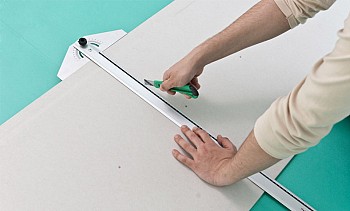Any product made of drywall must have a ridge - a frame made of durable parts. These are profiles and guides of various shapes, connected by various fasteners. In quality, they can be different. Alas, sometimes you can learn about a purchased marriage only during installation, or even when using a finished design. This is a problem for developers who do not have experience. Choosing the right types of profiles for drywall, they do not know how to find quality products. But here it is impossible to make mistakes, therefore, we will consider what types of profiles, components and fasteners for drywall are, and consider the selection criteria for these elements.
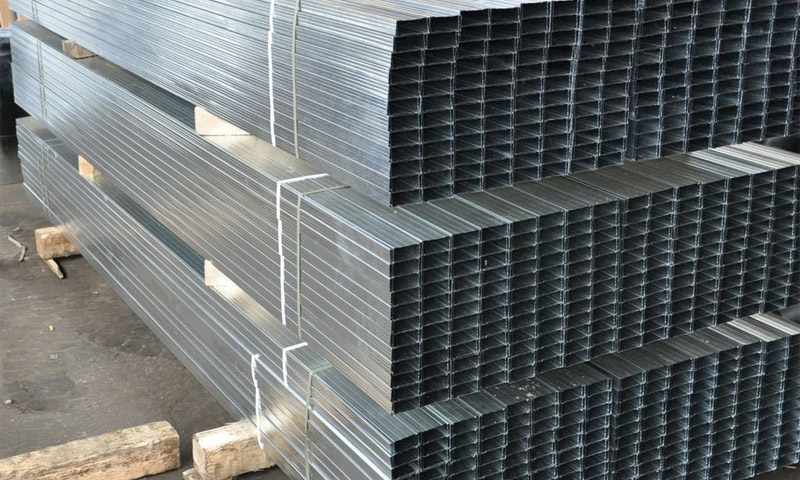
Content:
What are drywall profiles: types and sizes
For the manufacture of the profile using cold-rolled metal sheet processed by galvanizing. Products are strong, practical and reliable. After all, galvanized surface corrosion is not dangerous, and therefore this profile is destined for a very long life.
The metal frame used for the installation of drywall is simple in design. It includes horizontal and vertical parts. The latter are called supporting, or rack-mounted, elements. Perpendicular to them are guides, or starting elements. It is not so difficult to choose the suitable profile for drywall partitions. To begin with, we list all of their types.
Rack profile (CD or PP profile)
Rack profiles (also called ceiling profiles) are one of the most popular. According to the Knauf marking, they are indicated by the letters CD. Similar products of the Giprok brand are called PP profiles. Thanks to their optimally selected dimensions, space is used rationally and economically. When working in rooms of any size, there is practically no waste.

This profile is used for the manufacture of the frame for cladding walls and false ceilings.
Profile Sizes:
- Length - from 2.5 to 4 m;
- Width - 60 mm;
- The height of the shelves is 2.7-2.8 cm.
Guide profile for sheathing (UD or PPN)
UD (or PPN) profiles - guiding elements of the frame. Facing a wall with drywall or constructing a suspended ceiling, it is necessary to mount such parts around the entire perimeter of the plane. Since during the installation of these profiles, the drill passes directly through them, it is desirable that they be perforated. After all, it will be much easier to enter the drill holes.

They are used as guides into which rack profiles are inserted.
Dimensions of drywall rails:
- Length - 3 m;
- thickness - 0.55 mm;
- width - 2.7 cm;
- height - 2.8 cm.
Partitioning profiles - UW or PN
The guide profiles for creating partitions are marked UW or PN. In order to be able to make a partition of any thickness that is needed, these parts are produced with a large line of sizes, in particular width.

Used in the frame as guides when creating partitions.
Profile Sizes:
- Length - from 2 to 4 m;
- shelf height - from 3.7 to 4 cm;
- width - 4.2; 5; 6.6; 7.5; 10; 12.5; 15 cm
Partition profiles - CW or PS
Rack profiles for piers are marked with the letters CW or PS). In width, they are selected to the starting elements. Quality products always have a special notch to facilitate the laying of communications. The profile detail PS from Giproka has an additional stiffening rib, which creates a bent edge.

Used to create a frame for the installation of partitions.
Dimensions of the profile for drywall:
- Length - from 3 to 4 m (special lengths are made to order);
- the height of the shelves is 5 cm for Knauf and 4 cm for Giprok;
- width - in accordance with the UW or PN profile.
Arch profiles
Special curved profiles can have both a convex and a concave surface. They are used when it is necessary to make a structure of complex shape, with bends and curved planes (for example, an arch). However, if necessary, our craftsmen learned to do with rack profiles.

Dimensions of arched profiles:
| Concave | Convex | ||
|---|---|---|---|
| Radius mm | Length mm | Radius mm | Length mm |
| 500 - 1000 | 2600, 3100, 4000 | - | - |
| 1001 - 2000 | 1001-2000 | 2600, 3100, 4000 | |
| 2001 - 3000 | 2001-3000 | ||
| 3001 - 4000 | 3001-4000 | ||
| 4001 - 5000 | 4001-5000 | ||
| > 5000 | > 5000 | ||
What additional elements does the frame need
There are many auxiliary components for drywall - there are more than a dozen of them. But some of them can only be seen in the catalog, since they have a special purpose. And we will consider those elements that are used most often - they are enough for any master.

A two-level connector for a CD profile is used to secure these profiles at various levels. In this case, the directions are perpendicular to each other. Since this part is sold in the form of a reamer, we will give it the shape of the letter “P” before work, bending it for this. For installation, special self-tapping screws will be required (2 pieces - one from each edge).

Single-level connectors for a CD profile are called "crabs." They are designed to fix parts within the same level. As in the previous case, they are placed crosswise, perpendicular to each other. If the load per square meter is not more than 20 kg, then self-tapping screws are not required - it is enough to snap profiles. Otherwise, 2 self-tapping screws will be required - on one side and the other.

Direct suspension for CD profile is used when installing suspended ceilings. This part is fixed directly to the ceiling surface. Before connecting to the profile element, the suspension is bent in the form of the letter "P". Then screw, at the edges, 2 screws. The length of this product (standard) is 12.5 cm. Other options are also on sale - from 7.5 to 30 cm. The load that the suspension is ready to withstand is 40 kg.

Anchor suspension, also called traction suspension, also serves to connect the ceiling surface and the CD profile. It is needed when the direct suspension is of insufficient length. The suspension itself is inserted into the profile, and its thrust must be threaded through special holes in the spring. The thrust can be 25, 50 and 100 cm long. The maximum load is 25 kg.

An extension for a CD profile (otherwise, a longitudinal connector) is able to make the profile element longer. This part is inserted into it from the front side, while the protrusions, similar to horns, should be directed upwards. As usual, we screw two screws on the edges for additional rigidity.

The corner connector for a CD profile may well replace a crab element when installing suspended ceilings that have one level.
Plasterboard fasteners
Self-tapping screw TN 25

To securely attach drywall to metal surfaces, use self-tapping screws with frequent thread type TN25 (25 mm long). If the sheathing is in several layers, then they take screws 35-40 mm long. To attach GCR to a wooden crate, use screws with a wide thread pitch of 35 mm long.
Self-tapping screws LB 9, 11, 16 and LN 9, 11, 16

Attach a direct suspension, extend and connect various types of profiles for drywall need drilling screws type LB 9, 11, 16. Suitable and piercing screws LN 9, 11, 16. The numbers indicate the length of the screw in millimeters. The smallest drilling screw LB 9 has a length of 9 mm. All small fasteners have a drawback - they are difficult to tighten. A hat protrudes strongly and interferes with the fit of drywall.
Screws with a press washer

It is more practical to use universal self-tapping screws with press washers that can be used with any surface. They are made and piercing, and drilling type. Length varies from 9 to 100 mm, sometimes more. The most popular sizes are 16 and 14 mm, which can be used almost everywhere.
Self-tapping screws with nylon dowels

For fastening to the wall of the guide profiles for gypsum boards such as UW or UD, it is best to use plastic dowels.
Wedge anchor

Direct or anchor hangers are conveniently fixed to the ceiling using special anchor-wedge fasteners. It does not take corrosion, it is not subject to drying out, and therefore serves an impressively long time. In the manufacture of the ceiling is not worth saving. Fasteners must certainly be metal and durable. In addition, you can use a ceiling dowel.
Dowel nail

If we attach the frame (suspensions and guide profiles) to the supporting elements of concrete, brick or blocks, then we take special dowels. Suitable plastic fasteners with a fungal head, with a diameter of 6 mm and a length of 40 - 60 mm. They can be hammered directly with a hammer. Before work, you need to stock up on various types of fasteners in order to be able to connect any details, for example, hollow ones. When using rods instead of suspensions, take TDN anchors or their equivalents.
Tips for choosing quality fasteners and profiles
Before buying, check that the profile elements are even, have the appropriate size and undamaged galvanized coating. Being interested in how to choose a profile for drywall, remember that its thickness less than 0.55 mm is not allowed. Do not forget that not everything that is sold in the market and in the store meets the standards.
The following types of marriage:
#1. The metal is not thick enough - this is a big drawback. After all, then when working, the screws scroll, since the thread quickly breaks. It is easiest to check the thickness with a tool (vernier caliper). If it is not at hand, then as an option, you can compare profiles from different manufacturers.
#2. Traces of rust should definitely alert you. Since the corrosion process has begun, it will continue to continue. And one more thing: if a pack of profiles glistens with heavy grease, then this is an unkind sign. Most likely, the seller tried to disguise the fact that the coating is of poor quality.
#3. Incorrect rolling is visible almost immediately - just pull out a separate part from the pack. If you look at it along, you can see that the entire profile is twisted, and its shape, to put it mildly, is far from ideal. Definitely, you must refuse to purchase, otherwise you are tormented by exhibiting profiles. By the way, when they are stored incorrectly, similar problems also arise - the parts are bent and deformed.
#4. Inaccurate sizes are one of the most unacceptable types of marriage. Especially if the starting profile has a shelf height that is less than necessary. And it’s inconvenient to work, and the frame will turn out so-so. For smooth parts like CW, the shelf height must be exactly 5 cm, and for corrugated PS Gyproc-Ultra a slightly lower value is allowed. And even if the profile size for drywall is slightly less than necessary (2.48 m instead of 2.5 m, as some manufacturers do), you should not allow this.
#5. If the notch is made too rarely or too weakly, then it will be difficult to screw the screws. They dance for a long time on the surface, refusing to go to the right place. And if the ribs on the shelves of the CD profile are too large, then the LN screws are also not easy to screw in. Their sting invariably ends up on inclined planes.
#6. When buying fasteners, we check the tip - for this you can even try to screw a couple of screws into the metal. Visually check if there is any fastener in the bundle with a broken tip or metal residues. Check the heads too - they should have clear slots, well cut through. Otherwise, the bit will not stay on the screw. Rejection of the slots can consist in casting of poor quality or the metal that clogged it. There should not be any traces of rust.
#7. Never take a profile with burrs - all hands will be cut. Very dangerous and sharp thing.
#8. For dowels, check plastic plugs. If there are a lot of influxes, then pushing such plugs into the hole is difficult. The cork is weakly held in the hole and does not open well.

